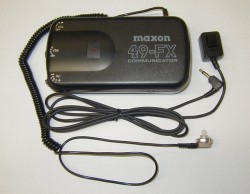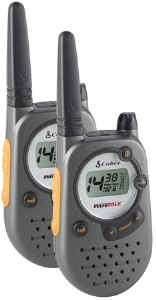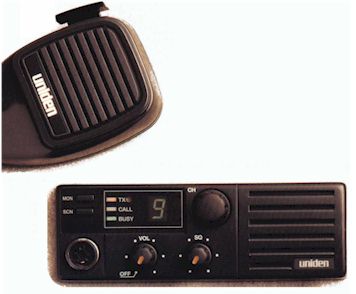License
Free Frequencies
There are several
sets of frequencies open to license free operation, meaning
no license is required.
49 Mhz
 The 49 Mhz frequency
range is popular due to the abundance of equipment available in this frequency
range. These are typically found in the form of kid's "walkie
talkies", although other more professional gear is available. Typical gear
available includes both handheld radios and radios worn on your belt with a
headset. There are not too many base radios available, although sometimes people
will convert old ham equipment to operate here. These sets
typically require large antennas. Other users of
these frequencies include baby monitors and cordless phones. Power output
is limited to 300mw.
The 49 Mhz frequency
range is popular due to the abundance of equipment available in this frequency
range. These are typically found in the form of kid's "walkie
talkies", although other more professional gear is available. Typical gear
available includes both handheld radios and radios worn on your belt with a
headset. There are not too many base radios available, although sometimes people
will convert old ham equipment to operate here. These sets
typically require large antennas. Other users of
these frequencies include baby monitors and cordless phones. Power output
is limited to 300mw.
49
Mhz Links
Yahoo
Groups - 49MHZ_Hobbyists
49
Mhz Experimental Radio Club
Multi-Use Radio
Service (MURS)

The MURS
frequencies lie in the VHF band. There is a limit of 2 watts output, but
external antennas can be used. Some base stations are available.
Commercial equipment can easily be adapted to this band and the quality of
of the radios is typically better than that of 49 mhz or FRS. The MURS
frequencies are:
- #1 - 151.820
- #2 - 151.880
- #3 - 151.940
- #4 - 154.570
- #5 - 154.600
Although there
is no such thing as "typical range", these radios have the
potential of reaching farther than FRS and 49 mhz due to their 2 watt
power limit and the characteristics of VHF signals. There is also no limit
on the emission mode of these radios, meaning you can do FM or digital
communications. A good source of radios for this band is Ebay. Radio Shack
used to sell MURS radios, but I believe they closed them out.
MURS
Links
Yahoo
Groups - MURS-OPEN
Yahoo
Groups - MURS
Personal
Radio Steering Group MURS page
FCC's
MURS Website
Family Radio
Service (FRS)
 FRS
frequencies lie in the UHF band. They are low power radios, typically handheld.
The price range varies quite a bit from $20 for a low end handheld to well over
$150 for the more feature-packed models. The power limit is 500mw, severely
limiting the usability of this service. It is mostly used by families, as the
name implies. No removable antennas are allowed. There are some base models,
which have antennas attached to them. The antennas on the radios are typically
small and most FRS radios allow you to select different "Privacy
Codes" (aka "PL" or CTCSS) and often come with the ability to
"page" another user so they can keep the radio on without hearing
everyone talking, until they are needed. Many FRS radio are actually
dual-service radios, containing frequencies for both FRS and GMRS. It is
important to note that one can only transmit on the FRS frequencies on these
radios unless they have a GMRS license (see below).
FRS
frequencies lie in the UHF band. They are low power radios, typically handheld.
The price range varies quite a bit from $20 for a low end handheld to well over
$150 for the more feature-packed models. The power limit is 500mw, severely
limiting the usability of this service. It is mostly used by families, as the
name implies. No removable antennas are allowed. There are some base models,
which have antennas attached to them. The antennas on the radios are typically
small and most FRS radios allow you to select different "Privacy
Codes" (aka "PL" or CTCSS) and often come with the ability to
"page" another user so they can keep the radio on without hearing
everyone talking, until they are needed. Many FRS radio are actually
dual-service radios, containing frequencies for both FRS and GMRS. It is
important to note that one can only transmit on the FRS frequencies on these
radios unless they have a GMRS license (see below).
FRS frequencies
are:
Channel No.
(MHz)
1...................
462.5625 8...................
467.5625
2...................
462.5875 9...................
467.5875
3...................
462.6125 10.................. 467.6125
4...................
462.6375 11.................. 467.6375
5...................
462.6625 12..................
467.6625
6...................
462.6875 13.................. 467.6875
7...................
462.7125 14.................. 467.7125
FRS
Links
Yahoo
Groups - FRS_GMRS_Users
Yahoo
Groups - FRS-Open
FCC's
FRS Website
General Mobile
Radio Service (GMRS)
 The
General Mobile Radio Service is not a "No-License" service, but if you
are looking for the ability to talk farther distances, use mobile and base
radios, talk through repeaters, and use higher power, but don't want to get an
Amateur Radio license, then GMRS might be good for you. The license costs $75
for 5 years. This allows you to use radios up to 50 watts output and you can
even access repeaters to increase the range of mobile and handheld units. The
FCC only issues GMRS licenses for families. Organizations can no longer get a
GMRS license. See the FCC webpage, below, for more info.
The
General Mobile Radio Service is not a "No-License" service, but if you
are looking for the ability to talk farther distances, use mobile and base
radios, talk through repeaters, and use higher power, but don't want to get an
Amateur Radio license, then GMRS might be good for you. The license costs $75
for 5 years. This allows you to use radios up to 50 watts output and you can
even access repeaters to increase the range of mobile and handheld units. The
FCC only issues GMRS licenses for families. Organizations can no longer get a
GMRS license. See the FCC webpage, below, for more info.
GMRS Frequencies:
| - |
-
A - |
-
B - |
-
C - |
| 1 |
462.550 |
467.550 |
462.5625 |
| 2 |
462.575 |
467.575 |
462.5875 |
| 3 |
462.600 |
467.600 |
462.6125 |
| 4 |
462.625 |
467.625 |
462.6375 |
| 5 |
462.650 |
467.650 |
462.6625 |
| 6 |
462.675 |
467.675 |
462.6875 |
| 7 |
462.700 |
467.700 |
462.7125 |
| 8 |
462.725 |
467.725 |
- |
- A - Base station
simplex, Mobile station simplex, Repeater Output frequencies
50 watts
- B - Repeater Input
Frequencies - Simplex NOT allowed
- C - Base and
portable simplex (Shared with FRS channels 1-7) 5 watts (FRS users
are still restricted to 500mw if they do not have a GMRS license)
Channel 6 A - National
"Emergency" Simplex
Channel 6 A/B - National
"Emergency" Repeater
GMRS
Links
Yahoo
Groups - GMRS Users
GMRS
Web
Personal
Radio Steering Group's GMRS website
G-M-R-S.org
GMRS.org
FCC's
GMRS Website
Click
here to return to my homepage
 The 49 Mhz frequency
range is popular due to the abundance of equipment available in this frequency
range. These are typically found in the form of kid's "walkie
talkies", although other more professional gear is available. Typical gear
available includes both handheld radios and radios worn on your belt with a
headset. There are not too many base radios available, although sometimes people
will convert old ham equipment to operate here. These sets
typically require large antennas. Other users of
these frequencies include baby monitors and cordless phones. Power output
is limited to 300mw.
The 49 Mhz frequency
range is popular due to the abundance of equipment available in this frequency
range. These are typically found in the form of kid's "walkie
talkies", although other more professional gear is available. Typical gear
available includes both handheld radios and radios worn on your belt with a
headset. There are not too many base radios available, although sometimes people
will convert old ham equipment to operate here. These sets
typically require large antennas. Other users of
these frequencies include baby monitors and cordless phones. Power output
is limited to 300mw.
 FRS
frequencies lie in the UHF band. They are low power radios, typically handheld.
The price range varies quite a bit from $20 for a low end handheld to well over
$150 for the more feature-packed models. The power limit is 500mw, severely
limiting the usability of this service. It is mostly used by families, as the
name implies. No removable antennas are allowed. There are some base models,
which have antennas attached to them. The antennas on the radios are typically
small and most FRS radios allow you to select different "Privacy
Codes" (aka "PL" or CTCSS) and often come with the ability to
"page" another user so they can keep the radio on without hearing
everyone talking, until they are needed. Many FRS radio are actually
dual-service radios, containing frequencies for both FRS and GMRS. It is
important to note that one can only transmit on the FRS frequencies on these
radios unless they have a GMRS license (see below).
FRS
frequencies lie in the UHF band. They are low power radios, typically handheld.
The price range varies quite a bit from $20 for a low end handheld to well over
$150 for the more feature-packed models. The power limit is 500mw, severely
limiting the usability of this service. It is mostly used by families, as the
name implies. No removable antennas are allowed. There are some base models,
which have antennas attached to them. The antennas on the radios are typically
small and most FRS radios allow you to select different "Privacy
Codes" (aka "PL" or CTCSS) and often come with the ability to
"page" another user so they can keep the radio on without hearing
everyone talking, until they are needed. Many FRS radio are actually
dual-service radios, containing frequencies for both FRS and GMRS. It is
important to note that one can only transmit on the FRS frequencies on these
radios unless they have a GMRS license (see below).  The
General Mobile Radio Service is not a "No-License" service, but if you
are looking for the ability to talk farther distances, use mobile and base
radios, talk through repeaters, and use higher power, but don't want to get an
Amateur Radio license, then GMRS might be good for you. The license costs $75
for 5 years. This allows you to use radios up to 50 watts output and you can
even access repeaters to increase the range of mobile and handheld units. The
FCC only issues GMRS licenses for families. Organizations can no longer get a
GMRS license. See the FCC webpage, below, for more info.
The
General Mobile Radio Service is not a "No-License" service, but if you
are looking for the ability to talk farther distances, use mobile and base
radios, talk through repeaters, and use higher power, but don't want to get an
Amateur Radio license, then GMRS might be good for you. The license costs $75
for 5 years. This allows you to use radios up to 50 watts output and you can
even access repeaters to increase the range of mobile and handheld units. The
FCC only issues GMRS licenses for families. Organizations can no longer get a
GMRS license. See the FCC webpage, below, for more info.